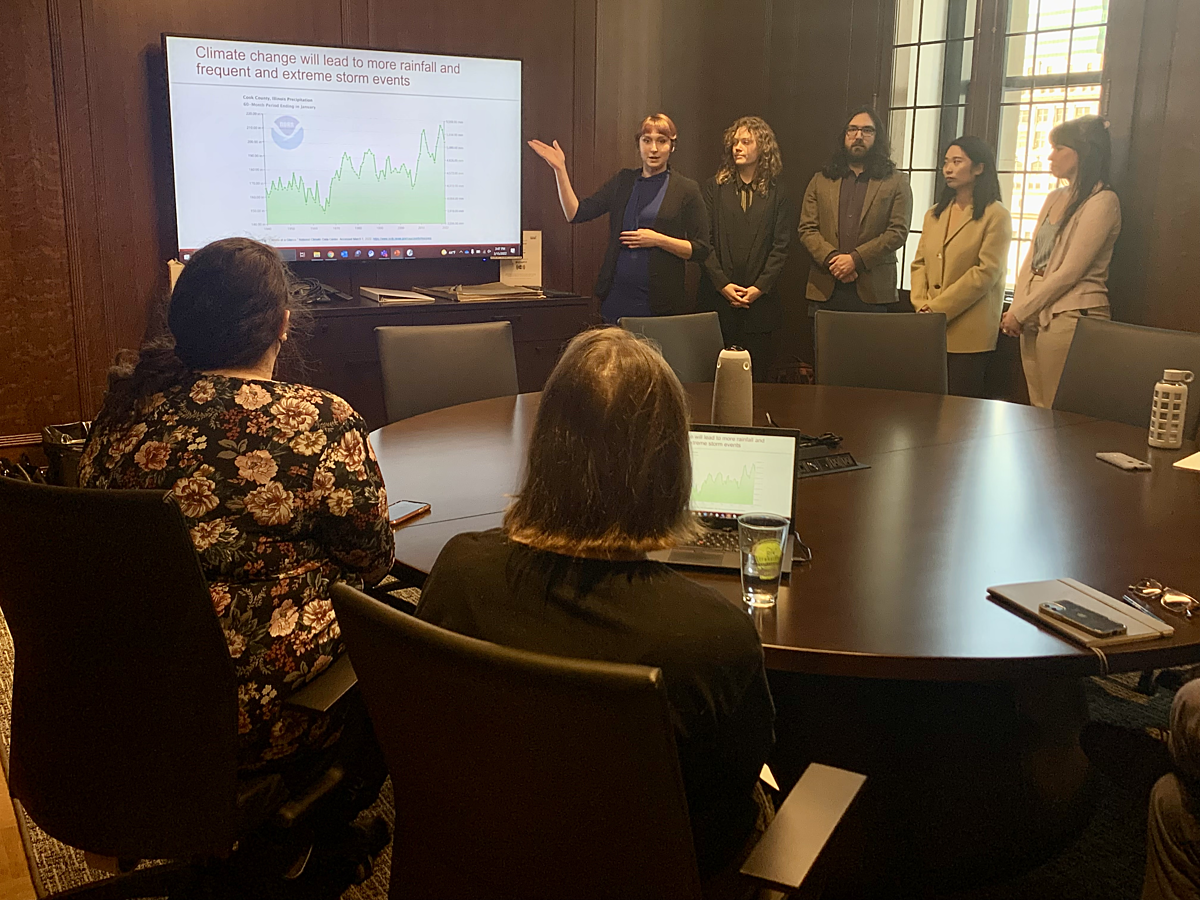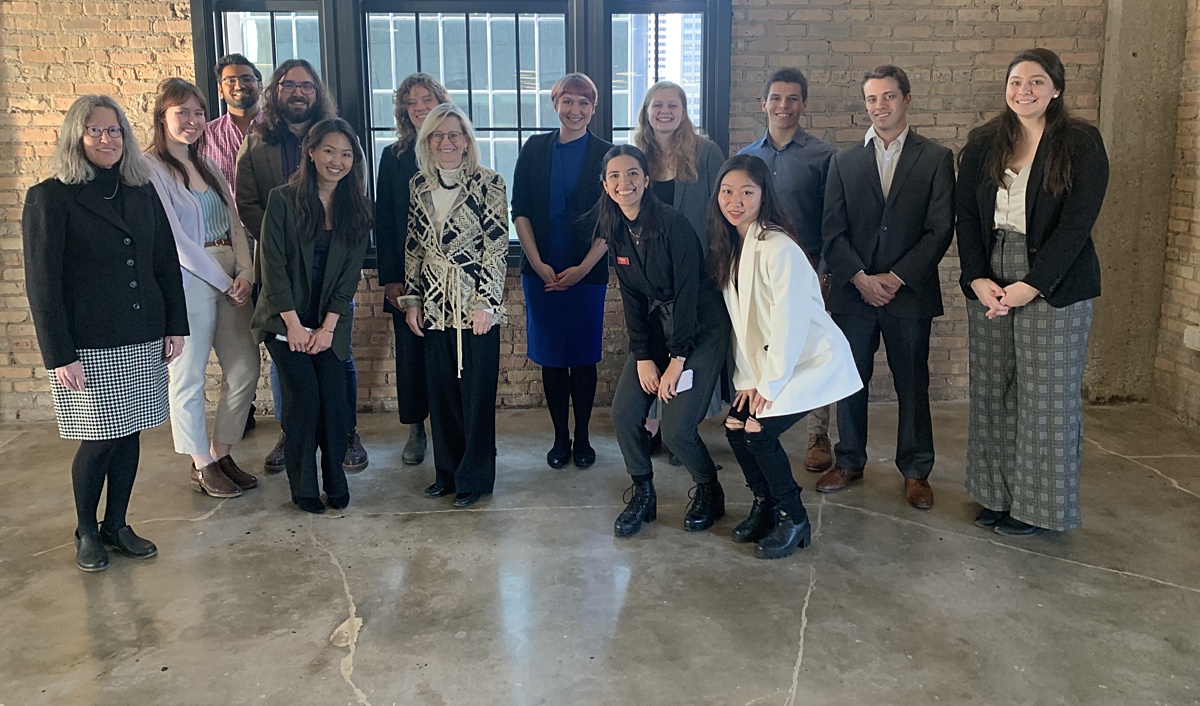Growing up in Brooklyn and spending her undergraduate and now graduate student years in Chicago, Chaillé Biddle has grown increasingly alarmed by the problem of urban flooding. When rainwater and stormwater overflow in developed areas, and the local sewer system cannot handle heavy downpours, that water fills streets and homes.
“Both of the places that I’ve loved and called home are long past the point of trying to avoid the worst and are really getting to a point of, how do we adapt, knowing that this is coming?” said the second-year student at UChicago’s Harris School of Public Policy.
In Chicago, urban flooding is especially problematic in lower-income and immigrant areas, where residents may hesitate to call on the city for help when basements and streets flood. And they are flooding at alarming rates: From 2010-19, only areas hit by hurricanes received more federal flood aid than the city and suburbs, a 2019 Chicago Tribune study found. The problems, of course, are only likely to increase as climate change makes extreme weather ever more likely.
With a team of fellow students working in Harris Policy Labs, Biddle early this year got to tackle the issue head on, making recommendations to the Chicago Metropolitan Agency for Planning (CMAP), northeastern Illinois’ comprehensive planning agency, on how it can identify the communities most vulnerable to flooding.
“This is an essential area of policy need,” said Biddle, 26, who returned to Harris for her master’s after working in the private sector following her 2017 graduation from UChicago with a BA in public policy. “My team and I were glad to work in such a relevant area.”
Among their recommendations the team identified four Chicago neighborhoods as being high in flood risk: South Shore and Pullman on the South Side and Belmont Cragin and Albany Park on the northwest.
In developing a specifically flood-related measure of social vulnerability, the team took into account the reality that many residents have an innate distrust of government agencies, a feeling, as Biddle summarized it, of “Why would they call the government, because government has never helped them before?”
Complications like these are one of the great values of the Harris Policy Labs program as it teaches “professional judgment,” said Paula Worthington, PhD, the program’s academic director. “Students are, for the first time, confronting the ugly realities of real-world policy work, where all of those datasets are incomplete, they all have imperfections, they all are not quite what you want” and the students must bring their own experience, intuition and study into play to help provide nuanced solutions to challenging policy issues.
Since 2016, Harris Policy Labs, an elective primarily for second-year graduate students, has done work for more than fifty government agencies and nonprofit organizations, including several City of Chicago departments; the City of Gary, IN; Cook County Health and Hospitals System; Metropolitan Planning Council; Oxfam America; the Illinois Medical District; and the Illinois Department of Human Services.
CMAP, the client for the urban flooding project, supports the seven counties and 284 communities of northeastern Illinois with comprehensive planning. Its ON TO 2050 plan helps communities implement solutions that address transportation, the environment, housing, economic development, land use and other quality-of-life issues.
“The students provided valuable insights and brought energy and excitement to our work. I know why the students find value in this opportunity but what they may not always see is the effect their enthusiasm has on CMAP staff,” said Elizabeth Scott, a principal policy analyst with the agency, referring to the experience as “refreshing and enlightening.”

Scott said she was impressed that the urban flooding students not only analyzed data but also conducted interviews with Metropolitan Water Reclamation District commissioners and with a lifelong Southwest Side resident impacted by urban flooding.
As the agency addresses flood mitigation and stormwater management going forward, the students’ “development of a flood-specific social vulnerability index is a result that will be of value to CMAP,” said Scott.
To find where flooding was occurring in Chicago, which the students focused on as the region’s densest urban area, they looked at insurance claims and also calls to the city’s 311 help line.
But even the validity of 311 calls as a grassroots datapoint had to be factored against residents being more likely to report street flooding, which the city could presumably address, than basement flooding, “which people, especially in immigrant communities – as we learned from this resident’s interview – tend to try to solve themselves,” said Biddle.
CMAP will take and tweak the student recommendations as the agency’s own professionals see fit, Worthington emphasized, “but I think what the (flooding) students offered CMAP is a structured pilot – a way to identify the communities of greatest concern who deserve the greatest attention.”

This was also true for two other Harris student groups, each of which tackled a different project for CMAP, said Scott. The group looking at how to increase electric vehicle charging infrastructure “did a good job narrowing in on certain key aspects of a broad policy area rather than offering a broader but superficial treatment,” she said, while the one examining possible implementation of traffic congestion taxes “provided valuable insights … when our team asked follow-up questions on topics ranging from traffic safety to revenue potential to public acceptance.”
Even beyond specific ideas, there’s a charge that comes from such collaboration, the CMAP planner added: “When we see the planners and policy analysts of tomorrow bringing new and innovative perspectives, we’re provided with an extra jolt of energy… at a time that truly demands profound change for northeastern Illinois.”



